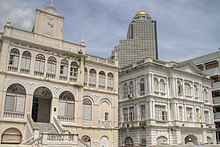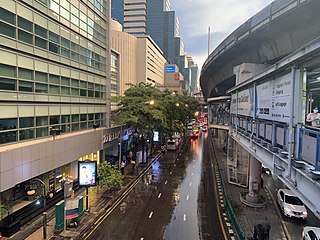
Si Lom Road is a major street in the Thai capital Bangkok, best known for its commercial neighbourhood, which, along with the nearby and roughly parallel Sathon Road, forms one of the city's main business districts. It runs in a southwest–northeast direction between Charoen Krung and Rama IV roads in the city's Bang Rak District, forming the boundary between Suriyawong Subdistrict to its north and Si Lom Subdistrict to its south. Si Lom was one of the earliest modern roads to be built in the city, and some of its side streets serve historic ethnic neighbourhoods from the late nineteenth century, while others are known as shopping and nightlife venues.

Bang Rak is one of the fifty districts (khet) of Bangkok, Thailand. It lies on the eastern bank of the Chao Phraya River, beyond Khlong Phadung Krung Kasem, which marked the old city boundary. Originating from riverside settlements dating from before the city's foundation, Bang Rak grew inland as new roads and canals were constructed through the area during the second half of the nineteenth century and the early twentieth, attracting communities of expatriates and developing into a major commercial district. Bangkok's rapid economic growth in the late twentieth century saw the areas along Si Lom and Sathon roads transformed into one of the city's main business districts, teeming with skyscrapers. The district, officially recognised at least since 1908, covers an area of 5.54 square kilometres (2.14 sq mi), and has a registered population of 48,227. Today, Bang Rak is known for the financial activity of its commercial offices, as well as its vibrant nightlife scenes. Diverse historic and religious sites, most significantly concentrated in Bang Rak Subdistrict on the waterfront, reflect the district's multicultural history.

Samphanthawong ; Chinese: 三攀他旺县) is one of the 50 districts (khet) of Bangkok, Thailand. Regarded as Bangkok's Chinatown, it is the smallest district by area in Thailand. Neighboring districts are Pom Prap Sattru Phai, Bang Rak, Khlong San, and Phra Nakhon.

Bang Kho Laem is one of the 50 districts (khet) of Bangkok, Thailand. The incumbent district officer is Samita Xanthavanij. The district is bounded by Sathon, Yannawa, and across the Chao Phraya River, Rat Burana, Thon Buri and Khlong San districts.
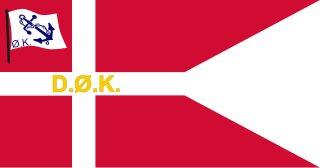
The EAC Invest A/S, formerly known as the Santa Fe Group and East Asiatic Company is a multinational holding and investment company, based in Copenhagen, Denmark. Originally founded by Hans Niels Andersen in 1887.
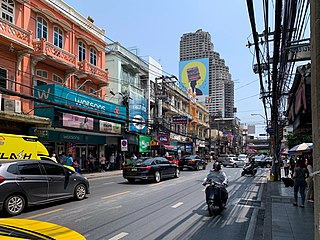
Charoen Krung Road is a major road in Bangkok and the first in Thailand to be built using modern construction methods. Built during 1862–1864 in the reign of King Mongkut, it runs from the old city centre in Rattanakosin Island, passes through Bangkok's Chinatown, continues into Bang Rak district, where it formerly served the community of European expatriates, and ends in Bang Kho Laem. Construction of the road marked a major change in Bangkok's urban development, with the major mode of transport shifting from water to land. Charoen Krung Road was Bangkok's main street up to the early 20th century, but later declined in prominence. It is still home to many historic buildings and neighbourhoods, which are beset by changes as extension of the underground MRT is poised to drive new development.

Bangkok's Chinatown is one of the largest Chinatowns in the world. It was founded in 1782 when the city was established as the capital of the Rattanakosin Kingdom, and served as the home of the mainly Teochew immigrant Chinese population, who soon became the city's dominant ethnic group. Originally centred around Sampheng, the core of Chinatown now lies along Yaowarat Road, which serves as its main artery and sometimes lends its name to the entire area, which is often referred to as Yaowarat. Chinatown's entire area roughly coincides with Samphanthawong District, and includes neighbourhoods such as Song Wat and Talat Noi along the Chao Phraya River, and Charoen Chai, Khlong Thom and Nakhon Khasem along Charoen Krung Road.

Asiatique: The Riverfront is a large open-air mall in Bangkok, Thailand. It occupies the former docks of the East Asiatic Company, and faces the Chao Phraya River and Charoen Krung Road. The complex opened in 2012 after extensive renovation of the site.

The Hotel Plaza Athénée was a 5-star hotel at 37 East 64th Street between Park Avenue and Madison Avenue on the Upper East Side of Manhattan, New York City, US.

Captain Bush Lane, now officially known as Soi Charoen Krung 30, is a side-street branching off Charoen Krung Road in Bang Rak District of Bangkok, Thailand. It was home to several members of Bangkok's early European expatriate community during the turn of the 19th–20th centuries, including Captain John Bush, an influential English sea captain after whom the street is named.

The old Customs House is a historic building in Bangkok, located on the eastern bank of the Chao Phraya River in Bang Rak District. It was built in 1888 as one of the many Western-style buildings commissioned by King Chulalongkorn, and was designed by Joachim Grassi in the neo-Palladian style. The building fell into disrepair during the mid-20th century. Beginning in 2019, it is undergoing restoration and re-development as a luxury hotel.
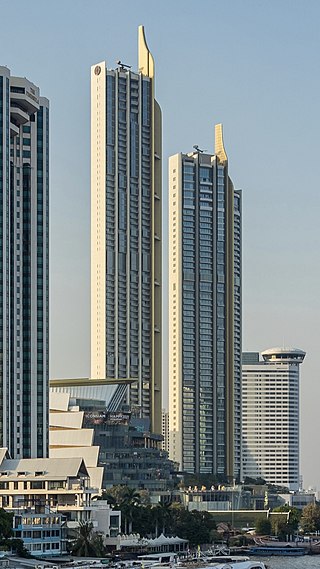
Iconsiam, stylized as ICONSIAM, and ICS is a mixed-use development on the banks of the Chao Phraya River in Bangkok, Thailand. It includes a large shopping mall, which opened to the public on 9 November 2018, as well as hotels and residences. The ฿54 billion project was jointly developed by Siam Piwat group, a Thai retail developer, MQDC Magnolia Quality Development, and Charoen Pokphand Group. The complex includes the tallest building in Thailand: the 70-floor Magnolia Waterfront Residences, and the country’s sixth tallest building: the 52-floor Mandarin Oriental Residences.

Thanon Tok is a road junction in the Bang Kho Laem Subdistrict, Bang Kho Laem District, Bangkok. It is a point of intersection where Charoen Krung, Rama III and Mahaisawan Roads meet. The boundaries of the junction are considered to be where Charoen Krung and Mahaisawan Roads terminates, and where Rama III Road originate.

Si Kak Phraya Si is an intersection in area of Wang Burapha Phirom sub-district, Phra Nakhon district, Bangkok. It is the intersection of Charoen Krung, Fueang Nakhon and Ban Mo roads. It is considered to be the second intersection of Charoen Krung, the first official street in Thailand, after nearby Saphan Mon.

Song Wat Road is a historic road in the area of Bangkok's Samphanthawong district. It has its origins by separating from Chak Phet road near Chakkrawat police station and foot of Phra Pok Klao bridge on the borderline of Chakkrawat sub-district, Samphanthwong district and Wang Burapha Phirom sub-district, Phra Nakhon district, then cuts across Ratchawong road in the area near Ratchawong pier, as far as ending at Khao Lam cycle, where it combines Khao Lam and Charoen Krung roads in Talat Noi sub-district in the area known as Sieng Kong (เซียงกง) or officially Soi Wanit 2. The distance is 1,196 m alongside Chao Phraya river almost all the length.

Wat Phraya Krai is one of three khwaeng (sub-district) of Bang Kho Laem district, Bangkok. It has a total area of 2.300 km2 west side along Chao Phraya river and in late 2017, it had a total population of 26,681 people.
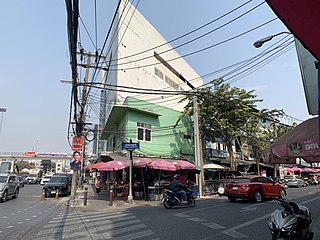
Charoen Rat Road is a road in Bangkok's Thonburi side. It serves as a "soi" or alleyway connecting Somdet Phra Chao Tak Sin Road and Charoen Nakhon Road. It passes through and overlaps between Khlong San and Khlong Ton Sai sub-districts within the Khlong San district on the Thonburi side of the Bangkok, in close proximity to the Chao Phraya River, which is one of the most important waterways in the city. On the side of the road near Wongwian Yai is beginning with the Wongwian Yai Market, one of the largest fresh markets in the Thonburi side of Bangkok. In the following area, it is a well-known center for the type of business and the road continues on to end at the intersection of Charoen Nakhon Road, which is a commercial center known as Iconsiam and a pier for crossing the river to the Phra Nakhon side. It also connects to the nearby areas of Talad Noi and Captain Bush Lane, which is an old and historic area.

Charoen Nakhon station is a Gold Line station, located in Khlong San District, Bangkok, Thailand. The station is on Charoen Nakhon Road, next to Iconsiam complex and opened on 16 December 2020.
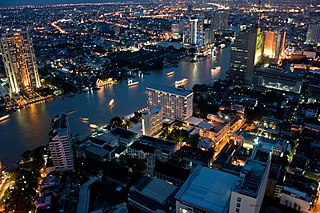
Bang Rak is a khwaeng (subdistrict) and historic neighbourhood in Bangkok's Bang Rak District. It lies between the Chao Phraya River and Charoen Krung Road, and was home to communities of European expatriates who settled in the area mostly during the second half of the 19th century as Siam opened up to the West. Among them were the Portuguese, French and British, whose embassies occupied extensive grounds in the area, Danes who founded shipping companies as well as the historic Oriental Hotel, and Catholic missionaries who established some of the first schools in the country on the grounds surrounding Assumption Cathedral.


